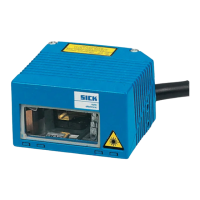Software Configurations
44
SICK Optic-Electronic
Bar Code Scanners
3
Protocol Type (Standard/Network)
Protocol is the method of data exchange between the CLV and the host computer. These settings frame the header, separator,
data, and terminator with the selected character values.
Standard (SICK)
“Standard (SICK)” refers to the standard SICK protocol for direct connection of the CLV to a host computer via the host port of
the CLV. (Refer to Figures 4-2 and 4-3)
“Protocol Send Start Character” directs the CLV to insert a selected character at the start of the data string as a start
character for protocol framing. The start character consists of one character and occupies one place in the data string. The char-
acter may be 01 to 1F hex. In most cases <STX> = 02 (hex) is used as the start character. This always precedes the header,
separator and terminator.
“Protocol Send Stop Character” directs the CLV to insert a selected character at the end of the data string as a stop char-
acter for protocol framing. The stop character consists of one character and occupies one place in the data string. The character
may be 01 to 1F hex. In most cases <STX> = 03 (hex) is used as a stop character. This always follows the header, separator and
terminator.
Note: In order for the CLV utility software to communicate, these values need to be STX and ETX respectively. If not, the soft-
ware will automatically set the CLV to these values to establish communication. Make sure you reset your requires values during
the last download.
Note: In order for a host device to send the host command language sets to the CLV, the command must be preceded by the
selected receive start character (STX) and must be followed by the selected receive stop character (ETX).
“Protocol Timeout” directs the CLV to repeat the data string last transmitted within the timeout duration, at request of the
host computer. The host must transmit control character <NAK>. Possible settings for timeout have a value from 0 to 9.99 s.
“Protocol X on/X off” directs the CLV to perform data exchange using X ON / X OFF software handshake method. With a
“no” response, the handshake method is not activated.
Protocol Block Check directs the CLV to insert the result of a block check in front of the stop character. Protocol Block
Check [BCC] consists of an element with two characters, representing a type of cross-sum across all the preceding characters of
the data string, including the character of the [START] Section.
[BCC] is determined by XOR linkage of these characters and is transmitted in HEX ASCII form. If [BCC] is inserted in the trans-
mitted data string, the CLV expects the incoming data string to also be equipped with a block check.
Handshake (Nak/Nak Framed/Ack-Nak/Ack-Nak Framed)
“Protocol Handshake” allows the user to select which type of handshake method is to be used. Choose between “Nak,” “Nak
framed,” “Ack-Nak” or “Ack-Nak framed”.

